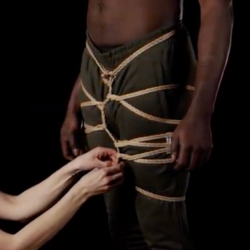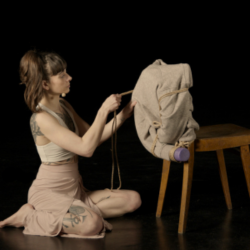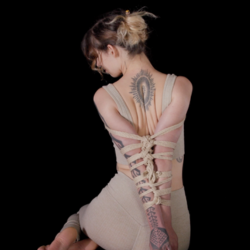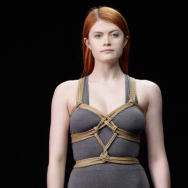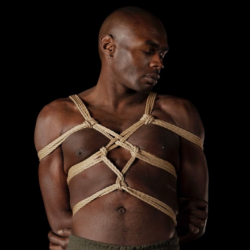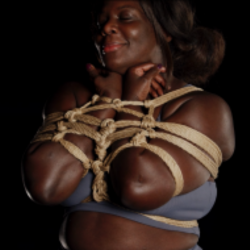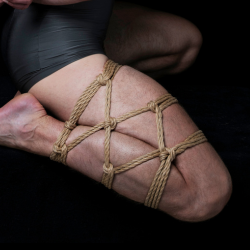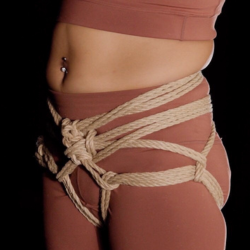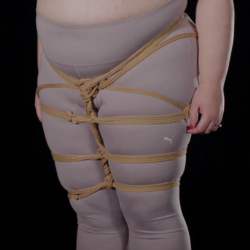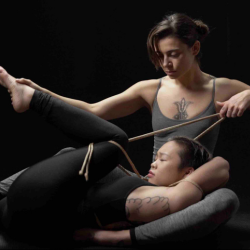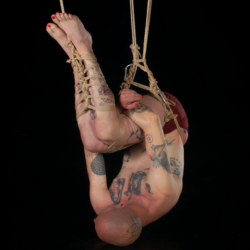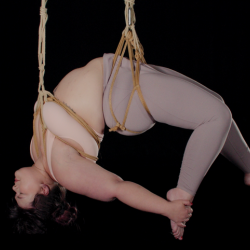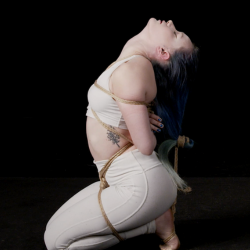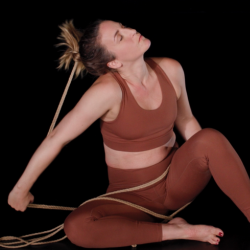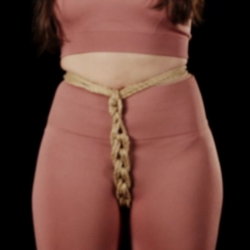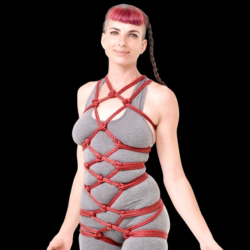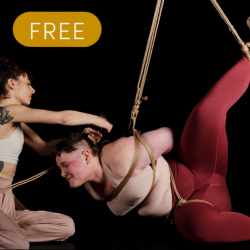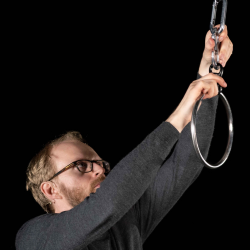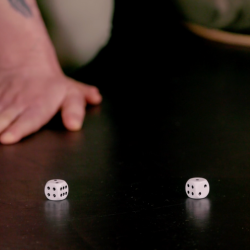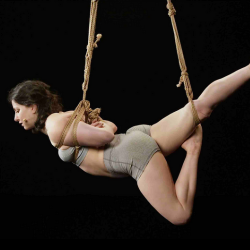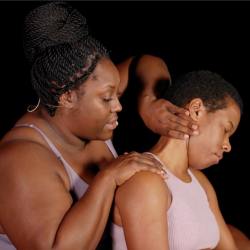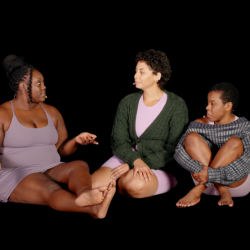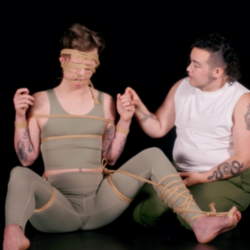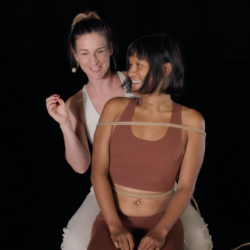EP 13
KNOTTY DEVIL
In this episode, Knotty Devil talks about how religion shaped his youth and discusses his approach to rope. He encourages people to tie for flow and break their movements down into how they're connected to the person they're tying.

Knotty Devil has been infatuated with rope bondage since he first saw a suspension performance five years ago. Since then, he has strived to learn from a variety of sources and is now a shibari artist.
Wicked Wren [00:00:18] Welcome to the Shibari Study podcast. I'm your host Wicked Wren. And today I'm talking to my friend, Knotty Devil. How are you?
Knotty Devil [00:00:26] Ah, good. I'm good. A little sleepy, but doing great. Had some coffee, so.
Wicked Wren [00:00:31] Maybe you need to go to bed earlier.
Knotty Devil [00:00:33] Actually, very true. I'm working on it.
Wicked Wren [00:00:35] Do you have a nighttime routine?
Knotty Devil [00:00:38] Um, I kind of – I definitely have a morning routine. I do not have a nighttime one. I'm usually, my roommates are usually up until 4 a.m. so sometimes I'm playing video games or hanging out with them, or sometimes it's like, No, I got to be up early, so I'm just going to maybe stretch and then sleep. It's about a 50% chance of me actually stretching or somehow winding down before I sleep. Otherwise, I just have a DND podcast or show on and just pass out with that in the background.
Wicked Wren [00:01:10] What is your morning routine? I'm fascinated by morning routines in general.
Knotty Devil [00:01:14] I literally wake up, roll over and post to all the social media that I have. I'm just like, Okay, here's – I'm doing posts on Reddit, I'm doing posts on this and that uses 30 minutes of me in my bed on my phone and then I shamble downstairs, make coffee, and then if it's a nice day out, I like to read either manga or a book on the porch because I'm in a big house and it's even if it's cold out, I have a nice coat. But if it's a nice sunny day, which is a rarity these days, I will be outside reading. If not, I will be upstairs in my little room, sipping coffee and reading as well.
Wicked Wren [00:01:57] That's amazing. How do you take your coffee?
Knotty Devil [00:01:59] Black.
Wicked Wren [00:02:00] Same. So you said that you wake up and you post. How often do you post?
Knotty Devil [00:02:06] Probably anywhere from 3 to 5 times a week. I'll usually be posting on Reddit or on Instagram or Twitter, whichever. Whatever content I have that works for that specific platform. But I usually try to post anywhere from 3 to 5 times a week and then OF. Of course, it's usually two to three times a week as well.
Wicked Wren [00:02:34] That's a lot of content to make to post. Are you thinking about that stuff in your sessions?
Knotty Devil [00:02:41] Yes, actually. Well, it depends on it depends on who and what I'm doing, because sometimes it's like, okay, if I'm doing a regular session with someone I've been talking with like super frequently will be like, okay, we're going to make a preview for Instagram, so I'm going to try a build, put you in it, take a quick shot that's like no (…), that's fully closed, and then, okay, next is going to be the one for Twitter. There can be a little (…), maybe a (…), and then like next is going to be the one that actually goes to OF. And so we'll do that like per pose sometimes. And other times it's not at all focused on that. But that tends to be the – if I'm like making content, I'm like, All right, let's get this shot, this shot of the shot, and then just call it good.
Wicked Wren [00:03:29] That makes sense. Really quick, there's a small clicking sound.
Knotty Devil [00:03:34] Yeah, that is my heart. I have two mechanical heart valves, so there is ticking. It cannot escape me, I'm afraid.
Wicked Wren [00:03:41] I've never heard of that.
Knotty Devil [00:03:43] Oh, yeah. It's, it's – you picked up on it so fast. Sometimes, it's really fun to be in a room and have someone look up and be like, Is there a clock in here? And it's funny because it's just a regular thing for me and I'm always excited to be able to explain it or maybe even try and come up with like a weird nerdy thing that's not that and just see how long it takes for people to understand that. No, I actually do just have two mechanical heart valves. At one point, I had someone on TikTok shoot me a message back when I had one and they were like, Hey, why is there this constant ticking in the background? I love your content, but I just can't stand the ticking. I'm like, I'm so sorry, I can't make it stop.
Wicked Wren [00:04:22] You're like, Trust me, we don't want to stop.
Knotty Devil [00:04:24] We don't want to stop.
Wicked Wren [00:04:26] Have you ever been around someone else and heard the ticking? And you're like, Oh, you have a mechanical heart valve?
Knotty Devil [00:04:31] No, I've really been I, I would love for that to happen. I have been like that, that would honestly be a dream is for me to recognize someone across the room and then do the same and both point to each other and be like, Ayee.
Wicked Wren [00:04:46] Thank you for sharing.
Knotty Devil [00:04:47] Yeah, of course.
Wicked Wren [00:04:48] So earlier you were talking about the role of documenting your sessions, and it's always cool to hear different people talk about the camera and what it does in a session because some people are really against photo rope and some people do rope for photos and for posting. It seems like you go in with a creative idea.
Knotty Devil [00:05:08] Yeah, well, it actually it changes based on the people that I am tying because there are people that are good friends of mine in my rope family or who are people that I'm making content with where we go in and the goal of the session is to make content. And then there's people like my partners or other members of my rope family where it's not really at all about making content. It's about the connection, the feeling, the flow. And so it really just depends on who I'm working with and what we all kind of like want based out of that. But I found that going into the session, if we're making content, it's good to come at it with the intent to make content and the intent to like, this is what will work on these different platforms and we'll pass and we'll be fine.
Wicked Wren [00:05:59] How are you looking at structuring your sessions? Do you go in with ideas or are you just kind of go with the flow after obviously an intake from your partners and things like that?
Knotty Devil [00:06:10] I think, so once we figure out, once we kind of build the general world that we're, that we're getting into, we're like, Okay, here's what we can do, here's what we want to do today. Or at least like, Okay, where, where do we not want rope on the body? How are we feeling? That kind of thing. And then moving on from there. It really depends on the environment. Are we, do we have a hard point? Do we not have a hard point? Do we have furniture or are we outside? And then based on that, it's kind of like, Okay, let's see, I want to make, let's play with this shape. And if it works, it works. If it doesn't – in fact, just the other day, I was doing a shoot and I decided I had an idea for a pose. And about halfway through, the person in rope kind of shifted and leaned one way and it just it looked so much better and it entirely changed the pose because I was like, No, actually I like this. This just has an aesthetic to it. Let's go with this. And so it's usually pretty flexible as to what we're going to be doing and maybe 50/50, I have a solid plan. The other 50 is like, Let's just kind of see where we end up.
Wicked Wren [00:07:23] You said something really cool and you said, I find out where we don't want to put rope and I find that most people do the opposite where they say, What do you want?
Knotty Devil [00:07:36] I think for us in general, a lot of times it's like, Okay, where – finding out where on the body you don't want rope today and so also kind of alongside like, Hey what harness don't you want to use. It gives us a lot more. So for example, my partner Leviathan has, is like, has been over the past few months recovering from a shoulder injury. And so whenever we were labbing out a tie recently, it was like, Okay, we don't want this pose, we don't want this pose and we can't have the rope going over this part of the shoulder. And so figuring that out and then kind of going with that, it kind of shows us, Okay, here's the things that we can't do. So now we have just so much more. We have so much more room for movement, instead of picking like, Here's one thing I really want or here's one or two places I really want rope, which is also good to know and we can play with that. But I find there's a lot more room for movement when you discuss the things that you specifically, the places you specifically don't want the rope.
Wicked Wren [00:08:47] Yeah, there's a million kinds of yeses as well, but there's only one kind of no and no is so definite and finite. Yes can mean yes, but, you know, or it could be a fake because you feel pressured to say yes. Like so many things. But a no, it's great.
Knotty Devil [00:09:04] Yeah, it is. And it's also really, it's a very helpful reminder because I have definitely, I had someone who I was doing a performance with and we had briefly tied or we'd have a history of tying, and then one of the places on the body changed where they were, where they felt comfortable with rope. And we had kind of discussed it before our rehearsal and then we went into doing it. And throughout that performance, I actually I did put rope on that part of the body because we had a whole history of tying that way. And I completely, it did space my mind and we checked in afterwards and which I'm so grateful to this person because they communicated, Hey, that was, that was – let's talk about that. And we did. And ever since that point, one of the things that we've brought into that is before every session being like, Hey, where on the body do you not want rope today? Or how comfortable are you with doing all of the rope that we have done in the past specifically? So it's fresh in my mind where on the body do not want rope? Especially if you're tying different people who have different ideas of what they want and different places. They don't want rope on the body. I might be tying someone one day who doesn't want rope on their feet and the next day tying someone who loves having rope on their feet. And it just, bringing that up beforehand, keeping it present in the mind is such a good thing that it's just kind of become a regular staple of my time with people.
Wicked Wren [00:10:38] It sounds like you created an environment that allowed for that person to say, Hey, that wasn't cool. Let's talk about it.
Knotty Devil [00:10:47] Yeah. Well, and that's also I understand that's a very difficult thing to do. I've definitely felt uncomfortable and rushed before and have struggled with my own, bringing that to the table because, you know, I was raised to be a people pleaser and it's a difficult thing for me to step up sometimes. So I have huge respect for the person that was like, Hey, this made me feel a little wonky and a little uncomfortable. Let's discuss it. And because that took so much courage. But I think that supporting that 100% makes them feel more comfortable. And I would, would absolutely much rather have people feel comfortable and be able to do that because communication is very important. And at some point in time, for me, I think the biggest thing that I really like when I'm tying to people is having that open communication. People who are able to say, Hey, actually let's change it up or Hey, let's do this. And people who feel comfortable enough to say those things, that's so, so important to me.
Wicked Wren [00:11:52] It sounds like you have a lot of bottoming experience.
Knotty Devil [00:11:55] Yeah. My first suspension intensive, I actually bottomed. It was a three-day intensive and I was bottoming for suspension and it was intense. But yeah, I actually got into the shibari scene as a switch and was definitely self-suspending. And because I wanted to be tied, I had always, it was something that both thrilled and terrified me and I wanted to be tied and I decided that I was going to tie myself and then eventually find other people to tie me.
Wicked Wren [00:12:30] You come from a really religious background, right?
Knotty Devil [00:12:33] Yes. Yeah. Extremely evangelical fundamentalism bordering on extremism.
Wicked Wren [00:12:41] How does that influence your rope bondage? Does it influence them?
Knotty Devil [00:12:46] I've known from a very, very early age that I loved rope and the idea of bondage. I was, I was playing tied games when I was six. I was thrilled by it. And I think that because the the specific sect of religion that I grew up with heavily discouraged any kind of of (…) exploration without the guise, I guess, or not the guise, without, within, without... Outside of the confines of marriage, any exploration that was heavily, heavily discouraged. And so I think that because that was just something that wasn't really even allowed or explored, I fixated on the rope aspect, that other kind of thing. And so throughout like growing up, that was a, a part of my, that was kind of my (…) awakening, if you will, was really more focused on the rope and on the (…).
Wicked Wren [00:13:51] Gotcha. And I do think that there's a footnote in the Bible that says that rope isn't allowed either.
Knotty Devil [00:13:59] I don't know. If there's a specific footnote of that. I know there's talks about bondage. And I know, me personally, I used to wear as a... I was 15 years old. I had these big leather bracelets on either hand. One pastor once approached me cause we have a regular kind of session where your, your pastor is kind of your therapist in that regard. And so I was like, Well, I'm worried about my, I have this, I feel like I have an addiction to bondage. And...
Wicked Wren [00:14:30] You said that?
Knotty Devil [00:14:31] Yeah, I did. I was I really wanted to be a good Christian boy at the time. And so I knew that I wasn't really allowed to have a community of (…) and rope and so I, at the time, thought I was a freak. I thought I was alone. I was scared. The only people I knew who did, who enjoyed tying people up were serial killers. And I was like, I don't think that I'm that, but I'm so worried that I might be. And I went to my pastor about it and was like, Hey, I'm having these feelings. And he was like, Yeah, no, bondage is a bad, bad thing. Don't do that. And actually made me, not made me, but heavily influenced me to no longer like wear the leather bracelets and throw those out as part of my penance, I guess, for that.
Wicked Wren [00:15:23] Wow. And then you just kind of stayed clean of bondage for a while. Did it work?
Knotty Devil [00:15:30] Oh, no, no. Okay, I definitely I actually almost got expelled from my, I went to a Christian school. My graduating class was ten, my high school was maybe 60 kids or the whole school through 12 of 60. And I got, I almost got expelled for breaking into the computer lab to look up just rope bondage, not even (…), but just soft bondage (…), I guess. And I, because we didn't have Internet at home because we were a very kind of strict closed off community. And so we didn't have Internet access at home. So I had to do it through the church or through the church in the school. We're kind of one of the same. And I ended up, we're doing a book report on (…) and I google imaged (…) and then suddenly realized that I had a whole world of opportunities open to me. And yeah, I almost got expelled and it kind of constantly started being brought up. I got in trouble a lot, I think probably between the ages of 10 and 14. I got in trouble a lot for, for playing tied games and then at 15 for looking at bondage (…) on the church laptop.
Wicked Wren [00:16:42] And so ironic because if they would have just given you regular (…) education, then you probably wouldn't have done all these things growing up.
Knotty Devil [00:16:50] Yeah. If they had if, if it wasn't something that was so, if it wasn't something that was so strict and so... Just like you weren't even allowed to have any exploration at all. If I was able to find a community and know that, Hey, actually it's okay to feel this way and know you're not going to be a serial killer, you're just too (…). You're just a (…) freak. And that's fine.
Wicked Wren [00:17:15] Yeah, well, and it seems like, you know, now you seem to adorn yourself and, you know, your hair is really cool and your nails are painted and you have jewelry. That's always really awesome. And it seems like you're, you know, customizing the canvas, if you will. Was that frowned upon growing up?
Knotty Devil [00:17:36] Yeah. So it's actually really funny because I think me, I think the first thing I came out to my parents about was rope before (…) preference. I think I almost kind of paved the way because the church, our church was very anti anti-gay. We were the, we were the people holding the signs at Planned Parenthood, like we were those people. We were the ones and so we were incredibly homophobic. And a part of me I accepted, at the time, I did not accept the gay part of me because I was like, you know, shove that down, got to survive. But the rope part of me, I accepted or was trying to and was struggling with in that regard. And I kind of just, once I had firmly accepted it, I was like, No, I also understand the argument of people who are like, No, I was born this way because I felt like I was born. My earliest memory was like a tie up game, and so I felt like I was born with this part of me. And so I was like, Oh, I can understand this argument and then ended up kind of exploring that side of myself and then being like, I like looking pretty. I like having – there was always, it was kind of that you see that movie. I forget which one of the Rocky movies it is, but Rocky's kid has like a dangly earring. And I was at a friend's house and watched that and I was like, Oh, I want to I want to look like that. I don't know if I don't know if I want to be that actor or if I want to sleep with that character. But, yeah, I want, I want the...
Wicked Wren [00:19:17] The angel of dilemma.
Knotty Devil [00:19:18] Yeah. And then I think I somehow got my hand on a copy of Lost Boys.
Wicked Wren [00:19:25] That'll mess you up.
Knotty Devil [00:19:26] That'll mess you up. And I was forever just absolutely taken with that and was like, Yeah, okay, this is my aesthetic, this is what I want. I want that hot vampire, vampire boy who questionably goes both ways. And then yeah, I had a tumblr that was fashion, that was all fashion blog, a bunch of shirtless guys and my friends are like, Are you sure you're straight? Yeah, I'm just into fashion. Slowly over the years, once I became kind of more comfortable with myself and my environment. Once I was outside of that, that very strict, very closed-off religious environment, I was able to actually breathe and come to terms with who I was.
Wicked Wren [00:20:13] So you're also really into competitive juggling. Is this related in some way? Did David Bowie juggle at one point?
Knotty Devil [00:20:24] Oh, you know, I think in Labyrinth there is there might be a the juggling of the thing but I think there was just something about it. There's a secret hidden flow and I will lose hours a day watching. There was a Russian juggler who, he can juggle knives blindfolded. And I've never seen anything like that. And there's, I just came across, there's a competitive juggling video where it's people in a ring and they're juggling back and forth between each other. And it looks like there's teams and there's commentators on like, Oh, this person's trying to swipe this baton away from this guy. And I'm like, No way is this a thing. And so now I'm kind of just deep diving into that. But there's some kind of hidden flow and presence involved and the the clowning that goes into it, the people who are super skilled jugglers who just don't even juggle for the first 10 minutes of the video but instead clown around and pretend to the stage presence. And there's just something there that I've always loved. But with juggling, it is that kind of, there is this hidden secret flow that I just, I want to know more about. I'm not very good at juggling. I can maybe juggle three things regularly or toss and catch a knife, and that's about the best of it.
Wicked Wren [00:21:46] You seem really in tune with flow in general. You're a longboard dancer as well. How do these things come into scenes with you?
Knotty Devil [00:21:56] I think there's a thing I do usually at the beginning,if I'm doing connective rope or rope flow where it's less, I just take a second to just breathe, take three deep breaths before even attempting the flow. But there's just, there's something about this. It's this silent, unspoken movement between two people where it's a shared movement, where it's that body manipulation, where you're moving the body a certain way with the rope or even just with pulling or twisting or something. And there's this moment of connection, this silent communication that's shared. That just, it fascinates me and I love it. And it's this ethereal headspace that I'm just, I get sucked into and I'm thrilled by it, especially the very specific rope-for-flow kind of scenes that we do.
Wicked Wren [00:23:04] Were there any early misconceptions around flow and rope and things like that that you came across?
Knotty Devil [00:23:11] Yeah. So there's this idea that rope flow can be, it's almost kind of partner dancing in a way where some partner dancing can be super flow-oriented and incredible communication and some can be very sensual. And with rope, there can absolutely be that kind of sensual. And some people then take that sensual a step further and like, Oh, well, if it's sensual, then it's (…). And it's kind of like, Well, there's actually kind of a huge chasm between those two things, and jumping from one to the other is a bit much. And it's kind of, there's this idea that just because there's this kind of chemistry that like, Oh, well, it absolutely has to go into (…). And I'm kind of like more of a demi person where it's like, No, I actually – there's a whole myriad of other things that are involved around (…), but it's that flow that is that is shared is not, does not have to be (…) and doesn't even have to be sensual. It can still be kind of that aspect of partner dancing that is that is flow that is not that. But there is definitely, I found kind of some people assume that all three are the one in the same and it's not that they really are.
Wicked Wren [00:24:34] That makes sense. I would love to hear a little bit about your negotiation, your intake process for a scene. Maybe with someone new or maybe with a partner that you've played with a bunch. Are there any standards there, some repeat things?
Knotty Devil [00:24:52] I think there is a lot because it definitely, one of my partnerships. We have kind of a, it might be, I don't know what the specific term is, I know everyone does like, Oh, blanket consent, castle consent. It's, I check in on like, Hey, is everything that we've done previously okay? Like up to this point, everything that we have played with previously, that's fine. That's how you're feeling. Kind of just has anything changed since we played last? And because we have that familiar partnership, that's kind of the base of that. And they also like to be kind of surprised as to like what we're going to do and not specifically spell out the same. And we have such good communication that I trust that they will speak up if something is not. Whereas if I'm doing, if I'm tying with someone new, it is, there is kind of like a whole questionnaire that happens before we even start. That's, Hey, what's your... Is there anything medical I need to know? Is there anything that, like once again, where do you not want rope on the body today? Where do you and especially, if it's someone I haven't tied with before. I've definitely made mistakes in the past where I have not set boundaries for myself. And it's something where it's like, Okay, for me specifically, I don't tie with mouth rope, crotch rope or neck rope the first time tying. And that's not something that has always been a thing. But I have learned from my mistakes that previously and been like, No, okay, I have to set boundaries for myself as well. But it's very in-depth negotiation. It's like, Okay, we set the specific intent for the scene, I guess, if you will. Like, Okay, what are we doing? Are we making content? Are we doing rope flow? Are we doing something a little bit more sensual and like, Oh, it's, there's some kind of aspect of a scene that is play. Do you want an artistic design? What are we going for? We set the intent and currently these days I'm mostly tying with the same people that I either have history with or people who I know pretty well. And it's something where there is definitely a huge difference between the negotiation that happens between someone new for me and a partner. But also there are some, I guess, it just really does differ based around the personal and the experiences that we've had and the trust that we have built up there. So yeah, I just kind of like, through so much information.
Wicked Wren [00:27:30] No, it's amazing. This is what we want. If you were in some weird world where you could only ask one question and you're telling someone new, what would the one question from your negotiation list be?
Knotty Devil [00:27:44] Oh, that's such a good question. I think it would be, what is your intent for this? What are you – What is the intent for this session?
Wicked Wren [00:27:59] That's a really good one.
Knotty Devil [00:28:02] Yeah, that's just seems, because you can say like, Oh, I don't want rope here, I don't want rope here, but that doesn't necessarily, you can still tie very sensually without having rope be on any genitals or on the mouth or around the neck. You can still absolutely tie sensually without those things. And you can still, there's so many different things that are involved, but just basing, gauging the specific intent of the scene is incredibly important.
Wicked Wren [00:28:30] That's great. Setting expectations. Getting on the same page. That's amazing. Really good answer.
Knotty Devil [00:28:36] Oh, thank you.
Wicked Wren [00:28:37] So if we can leave people with maybe one or two things that they can try in their session that you really like that are more flow-based, more connection-based. Do you have any, like little, you know, sequences that you'd like for that little opener things?
Knotty Devil [00:28:53] Yeah, I think two things. The first being, just tie. One thing I love to do, especially if I'm tying with, if we're for tying for flow is just put it single-column or double-column tie around the wrists and just in front of the person and then just pull on it a little bit, change, the intensity of the pull, pull soft pull, a little bit harder, maybe kind of move around and see how that person follows you. Are they a little bit more resistant? Are they jumping into it? Are they, not only being, allowing themselves to be led, but are they leaning into it and kind of very, very eager about that. Are they, kind of gauge their body movements and see. Because that also kind of just helps explore how that person wants to be lead in the rope and then kind of use that as a way to set aspect of intent for the scene or also start to play with that kind of thing. And I think the second thing would be every wrap of the rope over the body, every movement that you make, break it down into every moment, how am I connected to the person I'm tying currently? How – when I pull on the rope, am I just holding the rope? Is my, am I guiding their arms with my hand? Am I, how quickly am I pulling the rope or am I yanking it? Am I catching the breath or am I putting them on their toes? How are my actions specifically affecting the mindset of the person in the rope? How am I connected to that person? Think of almost putting yourself in that rope. How do I feel if my head is slowly lowered towards the ground while my arms are put above me. What feelings come up? What feelings arise in this? How do I feel if I'm swiftly brought from a kneeling position up on to standing on to my toes? How does that make me feel? How does that, how would I feel connected and kind of try and think about both sides. Um, and yeah, utilize that.
Wicked Wren [00:31:34] It sounds like there's a lot of active listening there. A lot, a lot of active communication.
Knotty Devil [00:31:41] Yeah, and I think that I have, I've have the privileges of being a switch is that I've both been in both sides of that, both tying and bottoming and. Been able to kind of think on that and also appreciate the non-verbal communication of others when, when I am being tied and then kind of taking that and utilizing it as well. But yeah, lot of nonverbal communication that is instinctively just kind of based off of – you're watching, how does their breathing rate change? What's the look on their face? What's the, is there, do I feel their body is a little more just kind of stiff and rigid in the shoulders. Are they kind of sinking and are they breathing a little more? Are they, just like going really, really slowly and taking your time to kind of just assess the reaction that the person in rope is having.
Wicked Wren [00:32:52] It's amazing. Well, I want to thank you for sharing all these nuggets. I mean, it's really, really cool to hear this.
Knotty Devil [00:32:59] Yeah. Thank you so much for this opportunity. This has been incredible.
Wicked Wren [00:33:02] You are welcome. And hope you have fun watching more juggling today. And again, thank you so much for being on.
Knotty Devil [00:33:12] Yeah, absolutely.
Wicked Wren [00:33:15] Okay.
Knotty Devil [00:33:15] Bye bye.
Start your free 7-day trial
Get one free week of unlimited access at Shibari Study,
then pay from $17.90/month. Cancel anytime.


